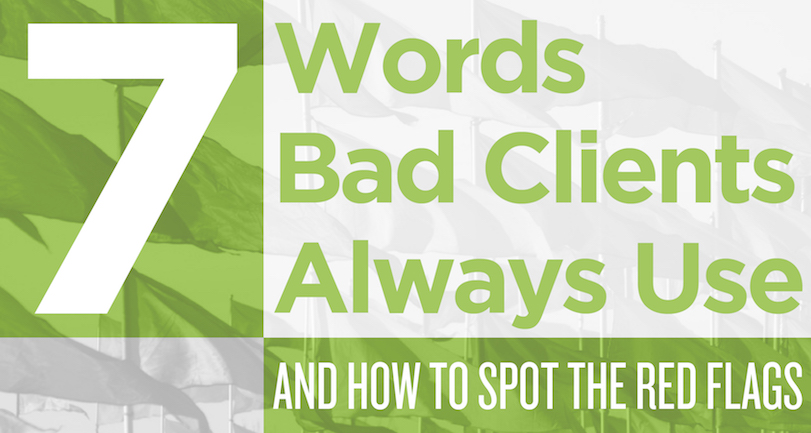
Guest post by James Crook
After freelancing for more than 8 years, I’ve come to learn that there are a few warning signs new clients will give you, letting you know that they’re going to end up being difficult to work with, slow payers, or even worse — no payers.

If you take your time during the initial communication stages, and pay attention to the words that the client is using, you can spot the same red flags, and keep yourself out of potentially frustrating situations.
Now, before we break down each of the words I’ve found common to most bad clients, let me give you a bit of a disclaimer. While these words are common to ALL of the bad clients I’ve had throughout the years, there have been times when really, really good clients have said the same things, only to have their minds and attitudes turned around when I explained the process to them.
That means you can’t instantly write off a client because they’ve used any of the words on this list. Instead, you have to trust your gut instinct, and make a determination on a case, by case basis to figure out if they’re going to be a pain, or if they just have unrealistic expectations and can be trained on how the process works, turning them from a serious pain to a long lasting relationship.
Without further ado, here’s 7 of the words I’ve found common to bad clients.
Word #1 – Cheap
If a client reaches out to you telling you that they’re looking for something “cheap” or “affordable”, your bad client radar should be pinging away. What they’re really telling you is that they don’t value your time, and usually don’t have a budget to work with.
If the client doesn’t value your time, they’re going to eat up every bit of it they can, and pay you peanuts in the process. If they don’t have a budget to work with, you’re not going to be able to make much money from them, are you?
While the relationships you build as a freelancer aren’t always about making a lot of money, they are about creating mutually beneficial situations that help your client get exactly what they’re looking for, while also making sure that you’re living a respectable lifestyle, paying your bills, and putting food on your table.
Word #2 – Quick
“Quick” is another dirty word clients love to toss around. When they’re telling you that the job will be “quick”, I’ve found it is usually the exact opposite.

You’re going to get bogged down in the details that the client didn’t think about before they reached out to you — or thought about, and wanted to hide from you so you could get suckered into the job.
If you take on these types of clients, you’re going to have to explain to them that nothing is quick, and delivering “quick” work usually means it’s not up to the level of quality you have built your business around.
By explaining to them how the process actually works, and the level of quality you prefer to deliver, you can usually turn around the relationship, set realistic expectations, and create a life-long client out of them.
Word #3 – Simple
“Simple” is along the same lines as the “quick” example. When a client tells you that the job is going to be simple, it’s not. Trust me on that. These types of projects have had some of the biggest scope creep I’ve ever seen, and a few have ended up being complete refunds when the project had been 140% complete.
Notice I said 140% complete. That’s well over 100%. I’d gone above, and beyond what the client was initially asking for, delivering even more content for the same price. This happened because the client’s “simple” job started growing, and growing, and I didn’t get them to pay up front, so my workload kept growing, and growing, too.
Word #4 – Spec
If you’re not familiar with the word “spec”, to freelancers it means that you’re going to be working on “speculation”. In other words, you’re going to be working for free, while the client speculates the outcome of the project, and pays you accordingly.

I can tell you that the spec work I’ve created has rarely paid, and when it does pay, it’s substantially less than my going rate. That’s been a painful, costly lesson for me to learn.
These days, when a client says they want “spec” work created, I’ll let them know that I do not write “on spec” and that I require payment up front. I take the time to explain to them how I operate, which typically sends most heading for the hills, but has let me build a few solid relationships from the clients who truly get it.
Word #5 – I Don’t Know
I don’t know.
When you hear this, it means exactly what they’re saying. They don’t know what they want, and expect you to read their mind. Except, their mind will always change, and you’ll be jumping on the mouse wheel trying to keep up with their changing ideas — which usually happens after you’ve already submitted work.
Clients that say “I don’t know” and also want to pay after the project is completed should be avoided at all costs. Trying to figure out what they really want, and then deliver on it is going to be a never ending task.
If you’re able to get the client to pay you up front, and agree to very specific terms concerning what you’re going to deliver to them, you can turn these relationships around, too. If they don’t agree to up-front payment, or can’t come to a solid conclusion based on the ideas you’ve thrown their way, you may want to avoid working with them.
Word #6 – I’ve Done This Before
When a client tells you “I’ve done this before”, what they’re really telling you is that they think they understand how you work, and are either going to micromanage everything you do, or are going to make unrealistic demands on your time.

For a project that would typically take you 8 hours to complete, they’re going to expect to have it over within a couple hours of you accepting it. Then they’re going to completely pick it apart, send you a list of demands on what needs to be “fixed”, and then expect the results in another couple of hours.
These relationships are a bit harder to save. To save them, you’re going to have to let them know you appreciate working with someone that’s done it before, and then let them know how you operate. You have to position yourself as the expert, and then get paid up front, while letting them know your workflow and how it ties into their deadlines.
Word #7 – More Work
Ah, the good old “more work” line so many clients love to use. I’ve figured out that when a client says “there’s more work in the future” or “I have all kinds of projects we can work together on” really means “I want you to do this cheap and here’s a carrot I’ve tied to the end of this stick”.
They’re going to constantly move the goal line, ask you to decrease your standard rates, and then usually disappear when you think the project is really taking off. I’m not sure exactly why it happens that way, but I’ve noticed that it’s usually the way it goes when the client starts talking about “more work” in your initial communications.
When you take the time to read into what your clients are telling you, before you start working with them, you can spot quite a few potential problems before they actually become a big problem for you.
The biggest lessons I’ve learned, when it comes to dealing with these types of clients is simple: tell them exactly how you work, what to expect from you, and how to pay you up front.
Then, you always have something to fall back on if they decide they want the project to take longer and include more than what you’ve agreed on, as well as the money in your bank account should you decide to fire them once the job is complete.
So, freelancers. Have you had experience with any of these types of clients before? Have you spotted your own red flags and warning signs that let you know how a relationship with a new client is going to go? If you do, share them in the comments below! We’d love to hear your stories!

James Crook – Author, Speaker, Web Marketer – is the best selling author of “Digitally Enhanced” and founder of marketing agency Choc Chip Digital. He works with hundreds of small businesses each year to grow their client base online, and is a passionate advocate for the power of authentic, heart-centred marketing. Widely recognised as a confident and articulate communicator, James draws on his love of digital technology to inspire, motivate and educate audiences across Australia.





